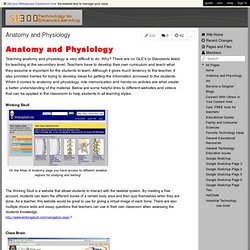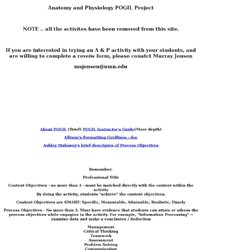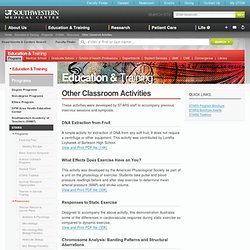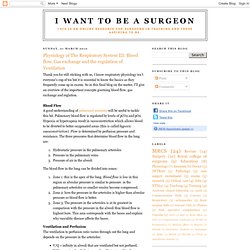

Curriculum-Anatomy and Physiology. University MCB/HHMI High School Science Outreach Program: Lesson Plans. The following resources were developed for classroom use by high school biology teachers who participated in MCB-HHMI Outreach's Summer 2005 "Experimental Biology and Multimedia Workshop".

This year's topic was "Neuroscience". Keep in mind that lesson formats vary greatly because each was developed with a particular classroom in mind. All lessons align with state and national science standards as described within the lesson or in an accompanying file. Please Note: Viewing any videos requires that you have the free Apple Quicktime Player installed on your system. If you would like to view pdf files in your browser window prior to downloading be sure to load the Adobe Acrobat Reader plugin. The Reflex Arc by Jerry Halpern (Introductory biology) Sleep: Why Do You Need It? By Margie Clark-Kevan (Introductory biology, includes three sleep related activities) Electroconvulsive Therapy And The Nervous System by Kerri Scott (Introductory biology, anatomy, bioethics) Student Worksheet by Sandra R.
DNA Lessons: Mutations, RNA Protein Synthesis, Biotechnology Labs. Technology-to-Enhance-Ed - Anatomy and Physiology. Teaching anatomy and physiology is very difficult to do.

Why? There are no GLE's or Standards listed for teaching at the secondary level. Teachers have to develop their own curriculum and teach what they assume is important for the students to learn. Although it gives much leniency to the teacher, it also provides barries for trying to develop ideas for getting the information acrossed to the students. When it comes to anatomy and physiology, rote memorization and hands-on activies are what create a better understanding of the material.
Winking Skull The Winking Skull is a website that allows students to interact with the skeletal system. Class Brain This website has many subjects, not just anatomy. BBC Science This site is from the BBC and the terms are a little different because the site is run in the UK but it still is a good resource for students studying anatomy and physiology. POGIL in Minnesota - Anatomy and Physiology. Anatomy and Physiology POGIL Project NOTE .. all the activites have been removed from this site.

If you are interested in trying an A & P activity with your students, and are willing to complete a reveiw form, please conatct Murray Jensen msjensen@umn.edu About POGIL (Brief) POGIL Instructor's Guide (More depth) Allison's Formatting Guidlines - doc Ashley Mahoney's brief descripion of Process Objectives Remember: Professional Title Content Objectives - no more than 3 - must be matched directly with the content within the activity By doing the activity, students "achieve" the content objectives. Content Objectives are SMART: Specific, Measurable, Attainable, Realistic, Timely. Learning_Activities. Other Classroom Activities-UTSW. These activities were developed by STARS staff to accompany previous inservice sessions and symposia.

DNA Extraction from Fruit A simple activity for extraction of DNA from any soft fruit. It does not require a centrifuge or other equipment. This activity was contributed by Loretta Loykasek of Burleson High School. View and Print PDF file (14K) What Effects Does Exercise Have on You? This activity was developed by the American Physiological Society as part of a unit on the physiology of exercise. Responses to Static Exercise Designed to accompany the above activity, this demonstration illustrates some of the differences in cardiovascular response during static exercise as compared to dynamic exercise. Chromosome Analysis: Banding Patterns and Structural Aberrations Field Epidemiology: Investigation of an Unknown Disease Through the use of a real-life example, this activity will expose students to some of the techniques used in field epidemiology studies.
Protein Folding Demonstration. Physiology of The Respiratory System III: Blood flow, Gas exchange and the regulation of Ventilation. Thank you for still sticking with us, I know respiratory physiology isn't everyone's cup of tea but it is essential to know the basics as they frequently come up in exams.

So in this final blog on the matter, I'll give an overview of the important concepts goerning blood flow, gas exchange and reglation. Blood Flow A good understanding of pulmonary anatomy will be useful to tackle this bit. Pulmonary blood flow is regulated by levels of pCO2 and pO2. Hypoxia or hypercapnia result in vasoconstriction which allows blood to be diverted to better oxygenated areas (this is called hypoxic vasoconstriction). Flow is determined by perfusion pressure and resistance. Hydrostatic pressure in the pulmonary arteriolesPressure in the pulmonary veinsPressure of air in the alveoliThe blood flow in the lung can be divided into zones:Zone 1: this is the apex of the lung.
Oxygen is predominantly transported by haemoglobin and only a miniscule amount is dissolved. Regulation. A & P Lecture Outlines. GE's pulse of the Games. A&P Ch. 3 - Virtual Gardner II. Cathy Hones's Page - The Flipped Learning Network Ning. Friday Institute for Educational Innovation - FIZZ.